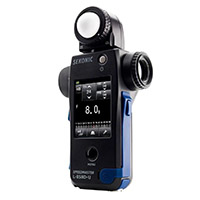Video: Incident vs. reflective metering, when should you use a light meter instead of your camera’s metering system?
posted Thursday, February 17, 2022 at 12:00 PM EDT

While light meters may not be the critical component of a photographer's kit like they once were, even with advanced metering systems in digital cameras, light meters remain useful for specific situations. One reason why is that a light meter can measure incident light, whereas a camera's metering system measures light reflected by your subject and other elements of a scene. A light meter can measure the precise amount of light falling on your subject, while a camera measures the light that bounces off your subject. In many cases, the different approaches may deliver similar results. Still, an incident light meter will more often be accurate, whereas a camera's metering system can occasionally come up short.
In the latest episode of his video series, 'Exploring Photography' for Adorama TV, Mark Wallace invites us into the studio to learn more about incident (light meter) versus reflective (camera TTL) metering. A cool aspect of some light meters, such as the Sekonic L-858D-U Speedmaster Light Meter that Wallace uses in the video below, is that it can perform both incident and reflective light metering, which offers a useful on-the-fly comparison.
What are some situations where reflective metering comes up short? When photographing images with a lot of white, like landscape photos with snow or bridal portraits where the subject is wearing a bright white dress, at default settings, camera metering systems meter for 18 percent gray. The white in your scene will become a slightly darker, muddier light gray. You can overcome this with exposure compensation or an incident light meter. It's not only pure white that trips up reflective metering, though, it can also struggle with black. At default settings, black is exposed as lighter and more like a dark gray.
An incident light meter doesn't care about the color of anything in your scene or even what your subject is. It simply measures the amount of light that enters the meter's lumisphere and then tells you proper exposure settings.
Are there situations when reflective light metering isn't just as good or nearly as good as an incident light meter, but better? The reflective light meter tool on the Sekonic light meter has a very small spot that it can use to measure reflected light, which can be useful when using advanced metering techniques such as the zone system. Suppose you don't want to know how much light is hitting a portrait subject in general but want to know specifically the amount of light being reflected by one of her cheeks, or her forehead. Whatever it may be, you can use TTL metering to measure that specific spot. You can read more about metering and the zone system by checking out this article by Cory Miller at Casual Photophile.
(Via Adorama)

